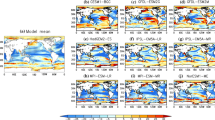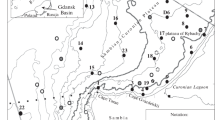Abstract
The oceanic primary production represents 40% of the Earth’s primary production. For this reason, it is admissible to state that the oceanic primary production plays a fundamental role in the global carbon cycle.
Access provided by CONRICYT-eBooks. Download conference paper PDF
Similar content being viewed by others
Keywords
1 Introduction
The oceanic primary production represents 40% of the Earth’s primary production. For this reason, it is admissible to state that the oceanic primary production plays a fundamental role in the global carbon cycle. The formulation of planktonic ecosystem models has been one of the main challenges regarding the carbon cycle (Yool 1997). The seasonal variations of the primary production, the influence of the environmental factors in the production cycles, the introduction of toxic substances in the food chain, and the influence of the hydrodynamic regimes in the production cycles are relevant research topics.
This paper presents a mathematical model to simulate the main phytoplankton dynamics of the Portuguese coastal zone based on either satellite and ocean buoy data measurements.
The model was formulated to study primary production mechanisms associated with solar irradiation and nutrients availability. It was able to simulate the seasonal cycle of chlorophyll-a concentration at different ocean locations (A, G, C, I) representative for the Portuguese territorial waters covering the regions of Madeira and Azores Islands (Fig. 1).
2 Materials and Methods
The model considers the main primary production mechanisms and forcing functions. It was formulated with a system of mass conservation equations for five state variables: phytoplankton, herbivorous zooplankton, nitrate, phosphates and silicate (Pinho 2001). Model parameters were calibrated using data from satellite sensors and global databases namely: chlorophyll–a; sea surface temperature; cloud cover and nutrients data from buoy databases. An optimization tool was used to estimate the model parameters and nutrient sources at the four ocean locations.
3 Results and Discussion
The obtained results for locations A and G are presented in Fig. 2. Dots represent the estimated data from satellite sensors and lines represent the simulated results. A scatter plot of simulated results and measured ones is also presented along with their correlation coefficient. A cross-correlation study was also carried out in order to analyze the model behavior along the year.
Better results were obtained for the northern areas compared to the southern areas where the results are not that good. For one of the southern locations, chlorophyll-a values of both satellite sensors (Sea-Wiffs and Modis-Aqua) do not present a positive correlation, especially during the spring bloom, which may explain the similar weak correlation between the model results and data from the two sensors.
The poor results for the southern studied areas may also indicate the influence of Mediterranean water masses (Cherubin et al. 2000), which are different from the Atlantic northern water masses (Martins et al. 2002). Thus, to obtain better results, a different mathematical approach would probably be necessary, considering two different sets of model parameters, in order to get the best response to the environmental characteristics.
4 Conclusion
A comprehensive database was implemented to support modeling the primary production for the studied areas. The model was able to simulate quite well the seasonal behavior in the analyzed locations within the Portuguese economic exclusive zone. For area I the chlorophyll-a concentrations values of both satellite sensors Sea Wiffs and Modis Aqua, do not present a very positive correlation. This explains the distinct correlation between the model results and the two sensors data.
The model is being used to implement a 3D primary production model for the Portuguese coastal area. The implementation of the physical model is almost concluded and the satellite data will be used for model data assimilation techniques implementation.
References
Cherubin LM, Carton X, Paillet J, Morel Y, Serpette A. Instability of the Mediterranean Water undercurrents southwest of Portugal: effects of baroclinity and of topography. Oceanol Acta. 2000;23:551–74.
Martins CS, Hamann M, Fuiza AFG. Surface circulation in the eastern North Atlantic from drifters and altimetry. J Geophys Res. 2002;107:3217.
Pinho JLS. Mathematical modelling application to hydrodynamics and water quality studies of coastal zones. Ph.D. Thesis. University of Minho, Braga, Portugal. 2001.
Yool A. The Dynamics of Open-Ocean plankton ecossystem models. Ph.D. Thesis. Department of biological sciences, University of Warwick, Conventry CV4 7AL, England, United Kingdom. 1997.
Author information
Authors and Affiliations
Corresponding author
Editor information
Editors and Affiliations
Rights and permissions
Copyright information
© 2018 Springer International Publishing AG
About this paper
Cite this paper
Pinho, J., Neves, D., Vieira, J. (2018). Mathematical Model for Primary Production Within the Portuguese Coastal Zone. In: Kallel, A., Ksibi, M., Ben Dhia, H., Khélifi, N. (eds) Recent Advances in Environmental Science from the Euro-Mediterranean and Surrounding Regions. EMCEI 2017. Advances in Science, Technology & Innovation. Springer, Cham. https://doi.org/10.1007/978-3-319-70548-4_474
Download citation
DOI: https://doi.org/10.1007/978-3-319-70548-4_474
Publisher Name: Springer, Cham
Print ISBN: 978-3-319-70547-7
Online ISBN: 978-3-319-70548-4
eBook Packages: Earth and Environmental ScienceEarth and Environmental Science (R0)






